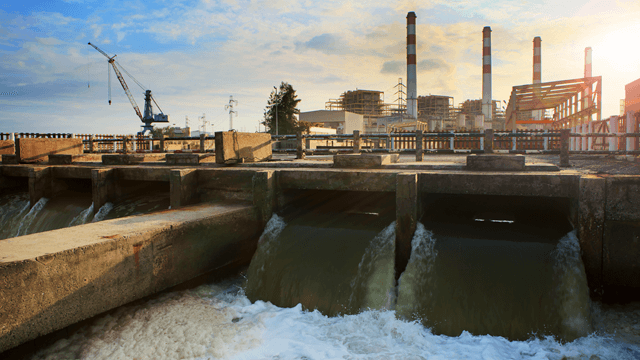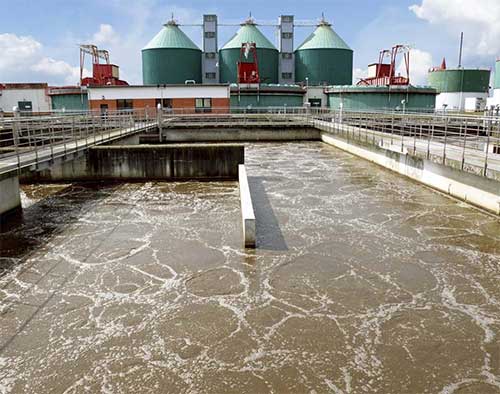Secret Methods in Industrial Waste Water Treatment Processes
The treatment of industrial wastewater is an important aspect of ecological monitoring, entailing an array of techniques created to reduce the effect of impurities. Advancements in technologies such as membrane layer purification and advanced oxidation procedures supply innovative remedies for boosting therapy efficiency.
Physical Therapy Techniques
Exactly how efficiently can physical treatment techniques resolve the intricacies of industrial wastewater? Physical treatment techniques play an essential duty in the preliminary phases of wastewater monitoring, concentrating largely on the removal of solids and large particulates. Strategies such as sedimentation, filtration, and flotation protection are important for decreasing the focus of suspended solids, consequently enhancing the effectiveness of subsequent therapy processes.
Sedimentation involves the gravitational settling of solids, allowing for the separation of much heavier materials from the wastewater. This method is particularly efficient in clearing up water before biological or chemical treatments. Purification, on the other hand, makes use of different media to catch particulate matter, ensuring that smaller sized contaminants are eliminated. This method can be customized to suit various sorts of commercial effluents, creating more clear effluent streams.
Furthermore, flotation protection techniques, which make use of air bubbles to lift suspended solids to the surface for elimination, work in dealing with wastewater with high concentrations of fats, oils, and oils. Overall, physical treatment methods serve as an important very first step in the thorough management of industrial wastewater, guaranteeing that the lots on subsequent treatment phases is minimized and improving overall therapy efficiency.
Chemical Therapy Methods
While physical treatment techniques lay the foundation for efficient wastewater management, chemical treatment strategies are vital for attending to the more intricate impurities often located in industrial effluents. These methods make use of different chemical agents to speed up, counteract, or oxidize unsafe substances, ensuring an extra thorough removal of toxins.
One typical approach is coagulation and flocculation, where chemical coagulants such as aluminum sulfate or ferric chloride are added to advertise the gathering of put on hold bits. This procedure boosts solid-liquid separation, reducing turbidity and boosting water top quality. Additionally, neutralization processes are used to change the pH of wastewater, utilizing bases or acids to reduce the effects of acidic or alkaline streams, respectively.
Oxidation-reduction responses play a critical role in degrading natural pollutants and pathogens. Chemical oxidants like chlorine, hydrogen, or ozone peroxide are utilized to damage down intricate organic compounds, making them much less hazardous or more eco-friendly. Progressed oxidation procedures (AOPs) incorporate multiple oxidation strategies to enhance pollutant elimination efficiency.
Biological Treatment Procedures
The performance of wastewater therapy is considerably improved by organic therapy procedures, which harness the all-natural metabolic activities of bacteria to decay natural issue and remove toxins. Industrial Waste Water Treatment. These procedures mainly involve anaerobic and cardiovascular food digestion, each customized for particular sorts of wastewater
Cardiovascular treatment processes use oxygen to sustain microbial growth, promoting the breakdown of natural pollutants right into co2 and water. Common methods consist of turned on sludge systems, where oygenation tanks help with the blending of wastewater with microorganisms, and flowing filters, which encourage biofilm advancement on media surface areas.
Conversely, anaerobic therapy processes take place in the absence of oxygen, using anaerobic germs to disintegrate organic matter, resulting in biogas production, a renewable power source. Anaerobic digesters are frequently used in commercial settings for this objective, properly minimizing the volume of sludge while producing beneficial biogas.
The selection of an organic therapy method depends on wastewater characteristics, therapy objectives, and regulative requirements. The combination of biological procedures in wastewater treatment not only enhances contaminant elimination effectiveness however additionally advertises sustainability by lessening chemical use and sustaining source recuperation.
Advanced Oxidation Processes

Typical AOP strategies consist of Fenton's reagent, photocatalysis, and ozonation. Fenton's reagent, a combination of hydrogen peroxide and ferrous iron, catalyzes the formation of hydroxyl radicals, making it effective for dealing with wastewater including phenolic substances and other stubborn materials.
AOPs offer several advantages, including decreased sludge manufacturing and the capacity to treat wastewater with high focus of organic toxins. Nevertheless, the application of AOPs requires mindful factor to consider of operational criteria and cost-effectiveness, guaranteeing that these innovative techniques are suitably integrated right into existing look at these guys wastewater therapy systems.
Membrane Layer Filtration Technologies

Microfiltration works for eliminating suspended solids and bacteria, while ultrafiltration targets smaller organic molecules and viruses. Nanofiltration bridges the space in between ultrafiltration and turn around osmosis, effectively eliminating divalent ions and organic substances. Reverse osmosis provides the highest possible level of filtration, used largely for desalination and removing mono-valent ions.
Membrane innovations supply many benefits, including low energy consumption contrasted to traditional treatment methods, modular layout for scalability, and the potential for water recuperation and reuse. Nevertheless, obstacles such as membrane fouling and the demand for normal upkeep must be dealt with to make sure system efficiency. Generally, membrane layer filtering modern technologies stand for an important component of modern industrial wastewater treatment methods, advertising sustainability and source preservation in water administration.
Final Thought
To conclude, industrial wastewater treatment employs a diverse selection of strategies, consisting of physical, chemical, biological, and progressed approaches. Each method plays an essential function in successfully resolving various contaminants, enhancing water quality, and promoting resource sustainability. The combination of these strategies cultivates a comprehensive treatment technique, ensuring that commercial effluents meet regulative requirements while minimizing ecological influence. Proceeded advancements in these techniques will better boost the effectiveness and efficiency of wastewater treatment processes in industrial settings.
The therapy of industrial wastewater is a critical facet of environmental monitoring, including a range of strategies developed to reduce the impact of contaminants.How efficiently can physical therapy methods address the intricacies of commercial wastewater?Advanced oxidation processes check out here (AOPs) stand for a sophisticated technique in industrial wastewater therapy, made to efficiently degrade natural pollutants that are commonly immune to standard treatment techniques (Industrial Waste Water Treatment).In final thought, industrial wastewater therapy uses a varied variety of methods, consisting of physical, chemical, organic, check that and progressed methods. Continued innovations in these approaches will certainly even more boost the efficiency and performance of wastewater treatment procedures in commercial setups
Comments on “Industrial Waste Water Treatment-- Comprehensive Solutions for Wastewater Disposal”